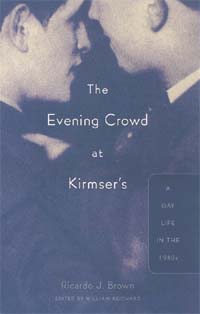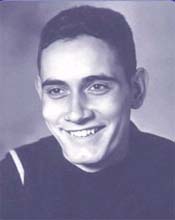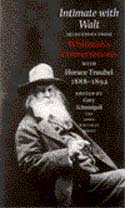 |
|
A Gay Life in the 1940s The Evening Crowd at Kirmser's: A Gay Life in the 1940s by Ricardo J. Brown; Edited by William Reichard; Foreword by Allan H. Spear; University of Minnesota Press; 155 pages; $21.95.
"Kirmser's was the underground queer bar in St. Paul, a hidden sanctuary for homosexual men and women in the 1940s. It was the haven I found in 1945 after being drummed out of the navy for being a homosexual. I was eighteen years old then and had only been in the navy for six months." The Evening Crowd at Kirmser's: A Gay Life in the 1940s are Brown's posthumously-published memoirs, a tribute to a long-gone place and time. Though World War Two was a liberating time for many gay men, these were still oppressive years for the "furtive fraternity". Even Kirmser's itself was "in the closet", "straight in the daytime and queer at night. To "the evening crowd at Kirmser's", the bar was "a fort in the midst of a savage and hostile population." It was also the uncertain start of a lesbian and gay community:
We all have memories of the first gay bar we went to on our way out of the closet (mine was The Nook in Coral Gables, a pitiful dive) and of the people we met there. Kirmser's and its patrons must have made an impression on young Ricardo Brown, since he kept enough memories to fill a small but potent book. Certainly the men and women at Kirmser's were the stuff memoirs are made of: Dale, "Flaming Youth", "Bette Boop" and Bud York, among others. All of them stayed within the confines of the closet, since they knew what would happen if they got out of line: "We all knew what the taboos were, from generation to generation, as well as the penalties for straying: banishment, disgrace, unemployment, ridicule, beatings, prison. Men did not show affection for one another, not even homosexuals. Not even at Kirmser's." Brown himself had suffered the indignities of a dishonorable discharge; Dale lost his job after he was outed by an anonymous informer; and "Flaming Youth" was beat up by two strangers in Kirmser's itself while his friends looked on. Others had it worse. Dickie Grant, next to Brown the youngest customer at Kirmser's, was murdered. Another patron, Red Larson, "was caught cornholing a guy in the back seat of his dad's car" during St. Paul's Winter Carnival. "Red spent a couple of months in the workhouse and he lost his job. After the workhouse, he was put on probation" and "forbidden to associate with 'known perverts'". Therefore, "he never came into Kirmser's again."
We can only be happy that Brown survived (he eventually got the Navy to review his discharge); that he enjoyed a flourishing career as a journalist; and that he lived long enough to write this book. The Evening Crowd at Kirmser's is a reminder of how life was in the bad old days; and a warning that we must do all we can to keep them from coming back. Intimate With Walt: Selections from Whitman's Conversations with Horace Traubel 1888-1892 Edited by Gary Schmidgall; University of Iowa Press (The Iowa Whitman Series); 319 pages; $22.95.
The result was With Walt Whitman in Camden; 5,000 rambling pages that ranged from the sublime to the trite. Traubel published Volume 1 of With Walt Whitman in Camden in 1888; Volume 9, the last volume, did not see the light of day until 1996. Traubel himself died in 1919. Not even the greatest Whitman scholar can go through the 5,000 pages of Traubel's masterpiece. Thus we are grateful to Gary Schmidgall, author of Walt Whitman: A Gay Life, for condensing With Walt Whitman in Camden into a manageable size. Intimate With Walt features the best of the Good Gay Poet's conversations with Traubel, organized by subject matter. Though it would have been better if Schmidgall had kept the chronological order that Traubel himself used, as a lover of Whitman I can only be grateful that he has finally made this valuable historical and literary resource available to us. |


 Ricardo J. Brown (1926-1998) was born in Stillwater, Minnesota. He joined the Navy during World War II, only to be given a dishonorable discharge for his homosexuality. Returning to a Minnesota closet, Brown found refuge in Kirmser's, a working class bar in St. Paul owned by an immigrant German couple:
Ricardo J. Brown (1926-1998) was born in Stillwater, Minnesota. He joined the Navy during World War II, only to be given a dishonorable discharge for his homosexuality. Returning to a Minnesota closet, Brown found refuge in Kirmser's, a working class bar in St. Paul owned by an immigrant German couple:
 Ricardo J. Brown
Ricardo J. Brown  In 1888, young Horace Traubel befriended the poet Walt Whitman, then living as an invalid in Camden, New Jersey. From that time until Whitman's death in 1892, Traubel kept a record of his daily visits, creating what Gary Schmidgall called "the most astonishing oral project in all of American letters."
In 1888, young Horace Traubel befriended the poet Walt Whitman, then living as an invalid in Camden, New Jersey. From that time until Whitman's death in 1892, Traubel kept a record of his daily visits, creating what Gary Schmidgall called "the most astonishing oral project in all of American letters."